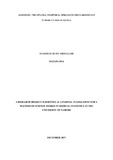| dc.contributor.author | Abdullahi, Suleiman H. | |
| dc.date.accessioned | 2018-01-11T12:23:22Z | |
| dc.date.available | 2018-01-11T12:23:22Z | |
| dc.date.issued | 2017 | |
| dc.identifier.uri | http://hdl.handle.net/11295/102334 | |
| dc.description | A Research Project Submitted as a Partial Fulfillment for a Masters of Science Degree in Medical Statistics at the University of Nairobi | en_US |
| dc.description.abstract | Background: Tuberculosis (TB) remains one of the world biggest public health threat. Over the last three decades there has been a remarkable decline in the TB incidence and mortality globally. However, the emergence and increasing spread of a drug resistant strains of Mycobacterium tuberculosis is threatening to derail the effort to eradicate tuberculosis. Kenya is among the 27 high MDR-TB burden countries that account for more than 85% of estimated MDR-TB cases in the World. Also ranked 13th among the 22 high-burden nations, that collectively account for up to 80% of the global TB Cases. Drug-resistant TB is not evenly distributed across Kenya, therefore identifying the Spatio-temporal pattern and areas of high risks of DR-TB will help government prioritise resources and allow for efficient deployment of interventions that are often in limited supply to the areas where they are most urgently needed.
Objectives: The purpose of this study was to utilized spatial methods to assess and predict the spatial risk distribution of drug resistant TB in Kenya.
Study design and sites: A retrospective cohort study using longitudinal data of notified cases of drug-resistant TB from the Kenyan national DR-TB surveillance database. The study covered all the 47 counties of Kenya, using county as spatial unit of analysis.
Material and methods: Exploratory spatial data analysis (ESDA), and Bayesian spatial model were employed to estimate the spatial risk pattern of drug resistance TB using county level data obtained from the national DR-TB surveillance database for the period of five years (January, 2012 to December, 2016).
Results: Between 2012 and 2016, there has been a remarkable change in the distribution of the empirical Bayes Smoothed notification rate and excess risk of DR-TB. The EBS maps revealed a significant temporal pattern in the distribution of DR-TB cases over the five years period (2012-2016). The local Moran test for the year 2016 has identified a significant clustering of counties with high risk of DR-TB. | en_US |
| dc.language.iso | en | en_US |
| dc.publisher | University of Nairobi | en_US |
| dc.rights | Attribution-NonCommercial-NoDerivs 3.0 United States | * |
| dc.rights.uri | http://creativecommons.org/licenses/by-nc-nd/3.0/us/ | * |
| dc.title | Assessing the spatial-temporal spread of drug-resistant tuberculosis in Kenya. | en_US |
| dc.type | Thesis | en_US |
| dc.description.department | a
Department of Psychiatry, University of Nairobi, ; bDepartment of Mental Health, School of Medicine,
Moi University, Eldoret, Kenya | |



